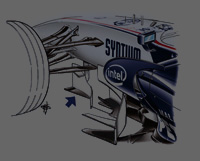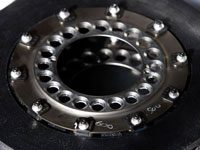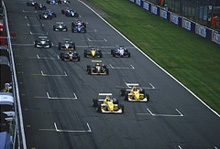
The single seat FORMULA 1™ racing car is quite simply the fastest, most technically sophisticated car designed to complete a lap of a race circuit. More than that, it is designed to complete fifty or more laps which make up the 300km distance that makes up a FORMULA 1™ Grand Prix. At the heart of every FORMULA 1™ car is its engine.
The scream of 22 cars leaving the starting grid is one of the most emotive moments of every race. As in every respect of the car’s design, the technical parameter of every FORMULA 1™ engine is strictly defined by rules set by the sport’s organising body, the Federation Internationale de l’Automobile (FIA).
What are the Rules and Regulations of FORMULA 1™ ?
|
| The minimum weight of a FORMULA 1™ car is 605kg and the car cannot weigh any less than this at any times during a race. Regular checks during practice sessions and at the end of each race monitor this. In fact most FORMULA 1™ cars start out lighter than this and the engineers use strategically placed ballast to exactly match the minimum weight and at the same time optimise weight distribution for the best handling. | |
|
| Structures and Safety | The construction of FORMULA 1™ cars and the carbon fibre, Kevlar and metal alloy materials used are strictly controlled by the regulations to maximise their safety. The main structure of the car comprises a safety cell which contains the cockpit plus a self sealing fuel tank, which is housed immediately behind the driver.
This safety cell must meet minimum size requirements and must have an impact-absorbing structure immediately in front of it. There is a similar, compulsory impact-absorbing structure at the rear, behind the gearbox. Every car also has two roll-over structures to protect the driver in the event of the car overturning. One is behind the driver’s head, the other at the front of the cockpit ahead of the steering wheel. The car and its survival cell must pass a number of strict impact and rollover tests before it is allowed to race. | |
|
 | | Engine and Gearbox | FORMULA 1™ engines have a maximum capacity of 2.4 litres and must be made up of 8 cylinders in a 90-degree formation, with two inlet and two exhaust valves per cylinder. They must be normally aspirated, with no turbochargers or superchargers, weigh at least 95 kilograms and be rev-limited to 19,000rpm. They are estimated to develop 700 horsepower. Each engine must also be used for two successive race weekend, otherwise the driver is penalised a minimum of ten places on the starting grid. |
| |
| FORMULA 1™ cars use a sophisticated seven-speed transmission. There is no clutch and no gear stick, instead the driver flicks a lever behind his steering wheel to change up or down and the gearbox makes the change. A new development for 2007 cars is a ‘seamless shift’ gearbox, which maintains constant acceleration even when the driver changes gear. The driver stays on full throttle and electronics carefully match engine revs on each gear change to get the car to top speed faster. |
|
| Tyres | FORMULA 1™ cars must have four, uncovered wheels, which with tyres fitted mustbe no more than 660mm in diameter (670mm with wet-weather tyres). Front wheels must be between 305 and 355mm wide, the rears between 365 and 380mm. From 2007, all teams must use the same types of tyre provide by Bridgestone. The dry-weather tyres are offered in two different specifications for each race, have four grooves and the spacing and depth of these grooves must conform to strict specifications. Except in the case of | |  | |
| a wet race, all drivers must use both types dry-weather tyre during the race. A white groove on the thread of the softer of the two available compounds will allow spectators to distinguish which tyre a driver is using, while bar codes on every tyre allow the FIA officials to monitor their use and ensure that no team is breaking regulations. |
|
| Race Duration | | The race distance is set for all Grand Prix to be as close to 300km as possible. The number of laps of each race reflects this overall distance. Should a combination of say, wet weather, safety cars and a slow track conspire to lengthen a race, a maximum time duration of two hours will be imposed regardless of distance completed. | |
|
 | | Starting Procedure | There is a very strict starting procedure which teams and drivers must follow for every Grand Prix This commences 30 minutes before the formation lap when the pit lane is opened and drivers are free to complete reconnaissance laps of the circuit before taking up their positions on the starting grid. The pit lane closes 15 minutes prior to the formation lap. Any drivers still in the pit lane at this time will have to start the race from there. Ten minutes before the start the grid must be cleared except | | |
for technical staff, race officials and drivers. With three minutes to go all cars must have their wheels fitted and be ready to go. Any car not complying will have to start from the back of the grid or the pit lane. With a minute to go, all cars must have their engines running. All personnel must then leave the grid at least 15 seconds before the green lights come on to signal the start of the formation lap. During the formation lap, overtaking is forbidden, unless passing a car that has slowed due to a technical problem. Once all cars have safely taken up their grid positions at the end of the formation lap five red lights will appear in sequence at one-second intervals. When these red lights are extinguished, it signals the start of the race. |
[sumber :
Singapore F1 GP]





















.jpeg)


















































No comments:
Post a Comment